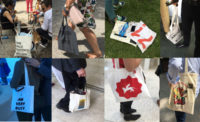Three of the most eloquent voices at the Venice Architecture Biennale addressed different aspects of the same question: Can architecture improve lives in Africa?
The first such voice belonged to Kunlé Adeyemi, the Nigerian architect who, at the behest of director Alejandro Aravena, built a replica of the Makoko Floating School, which Adeyemi created in 2013 for a watery slum in Lagos. In its current location, off the vast Arsenale where Venetians once built ships of war, this A-frame ship for learning is startlingly fitting.
The second such voice belonged, surprisingly, to Norman Foster—an architect normally associated with glistening first-world projects. But Lord Foster came to the Biennale to unveil his Droneport. If that sounds science fiction-y, it isn’t. The inaugural project of the Norman Foster Foundation (established by the architect and his wife, Elena), the structure is meant to house drones for humanitarian purposes. The architect passionately described how drones could be employed to bring necessities, including medical supplies, to remote villages in Africa with no reliable road access. “Drones could go from killing machines to living machines,” he said, envisioning fleets of unmanned craft with wingspans of 20 feet or more performing vital services.
In order to deliver these necessities, the drones will need secure places to load and unload on the ground. Jonathan Ledgard, a former journalist and founder of the Pioneering Redline Cargo Drone Network, enlisted Foster to design the ports, which he did with the Cambridge, Massachusetts-based engineering firm Ochsendorf, DeJong & Block. Made of hollow clay bricks, the vaulted droneport is designed to be built largely on site in Africa. Only the molds and hand tools would have to be delivered; the rest of the work could be done by locals (In Venice, the port was built by students). A pilot project with the government of Rwanda — think of it as a pilotless pilot project — is already underway, said Foster.
Basel-based architect Manuel Herz answered the question about Africa with his project about the refugees of Western Sahara. Herz has devoted a decade (so far) to documenting the plight (and not unoccasional pleasures) of the Sahrawi people, forced by war to escape from Moroccan military forces to Algeria in the 1970s. They live in camps, but they have subverted the “temporary housing” paradigm by bringing intelligence and even humor to the designs of their houses, public buildings, and communal spaces.
For the Sahrawis, the camps are a literal form of nation-building. The trouble is that “instead of solving the problem of the Western Sahara politically, it has been solved architecturally,” says Herz, describing the architectural victory as only a stopgap. Working with the Union of Sahrawi Women, Herz set out to make both an architectural and political case, first persuading Aravena to let him have a prime location for his pavilion — said to be the first at a Biennale devoted to a people in exile —in the center of the Giardini. From outside, the pavilion resembles a tent covered in silvery jute. Said Herz, “I wanted something more than the shack you might expect.”
Inside are images in two very different media: Large photos by RECORD contributing photographer Iwan Baan capture the lives of Sahrawis, while vividly pictorial black and white rugs woven by some 30 Sahrawi women offer maps and architectural renderings in a personal yet direct manner.
Through this exhibition, Herz hopes to make the Sahrawis more visible. Adeyemi hopes to find a permanent home for his second floating school—which took home the Silver Lion award—after the architecture Biennale closes in November. And Foster, a lifelong aviation junkie, hopes his involvement will bring attention to a project that could help millions on the ground.
















Post a comment to this article
Report Abusive Comment